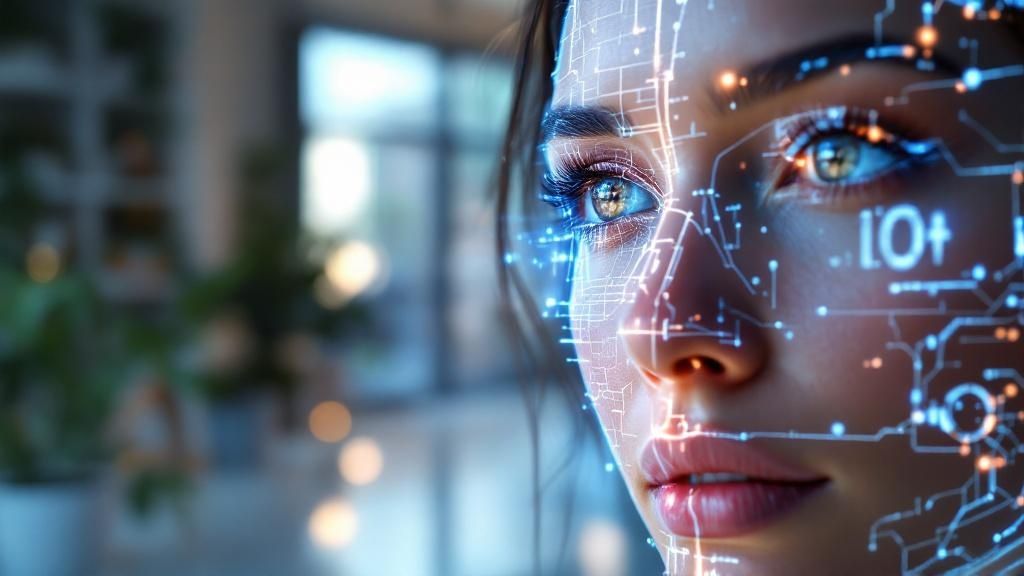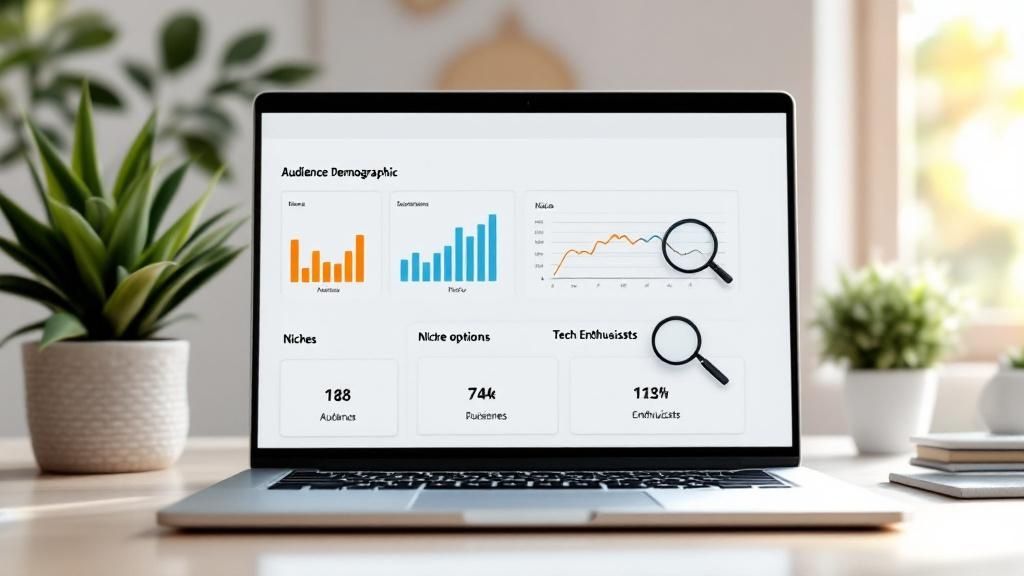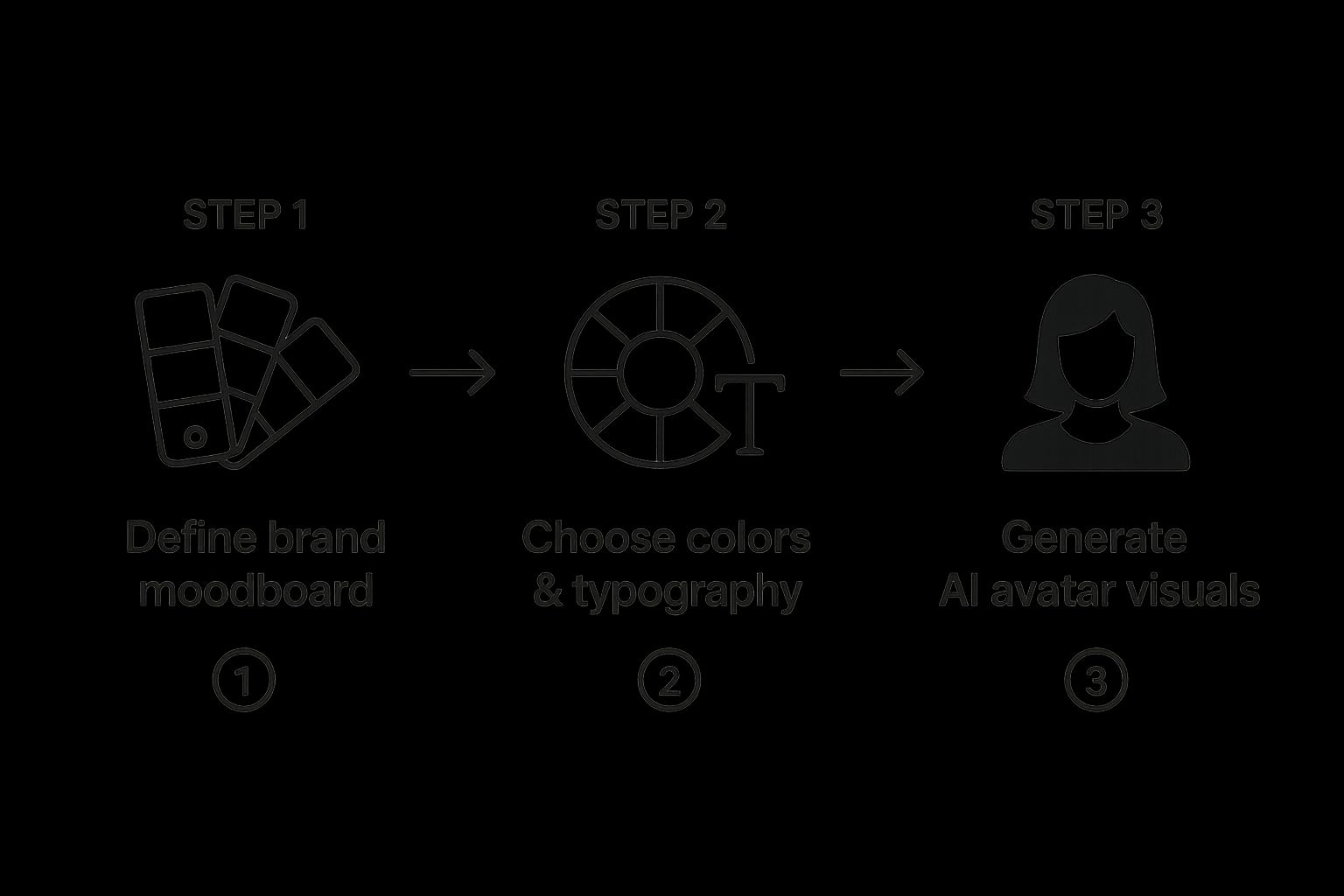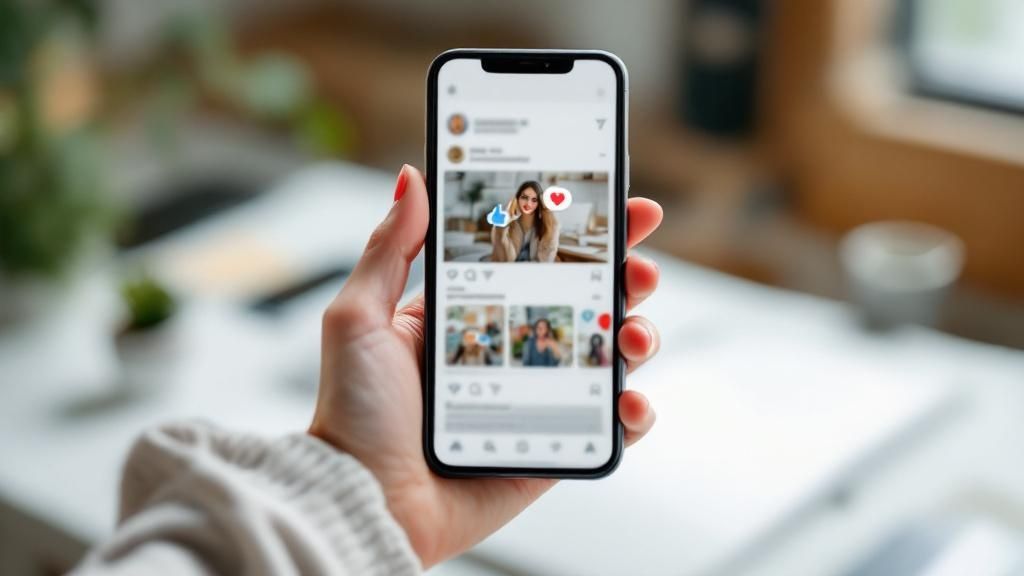
How to Create an AI Influencer That Captivates Audiences
Learn how to create an AI influencer from concept to monetization. Our guide covers persona design, content strategy, and community growth for virtual stars.
Table of Contents
So, you're thinking about creating an AI influencer. It's more than just a tech project; it’s about blending creative vision with powerful AI to build a digital personality from the ground up. You define their unique persona, craft a consistent visual identity, and roll out a content strategy to build a real audience.
Why Create an AI Influencer in Today's Market
Before we get into the "how," let's talk about the "why." This isn't just a cool gimmick. Building a virtual influencer is a serious business move that puts you right at the heart of a booming market. The appeal is about more than just novelty—it offers some very real advantages that human creators simply can't match.

The virtual influencer space is seeing explosive growth. What started as a niche experiment has quickly become a major commercial force. The market was valued at around $6.06 billion in 2024, and experts project it will surge to an incredible $45.88 billion by 2030. This isn't just hype; it's being driven by real advancements in AI and 3D modeling that make these digital personalities more believable and engaging every day. The full market analysis and projections really paint a clear picture of where this is all heading.
Unlock Complete Creative Control
One of the biggest draws is the absolute control you have. A virtual influencer can't get caught up in a real-world scandal, go off-brand, or have an unpredictable outburst. You meticulously craft every single post, collaboration, and public statement to perfectly align with your strategy.
This control extends to their entire existence. Your AI influencer can:
- Work 24/7, engaging with followers in any time zone without ever needing a break.
- Be anywhere in an instant, from a digital version of Paris Fashion Week to a completely imaginary world, all without a single travel expense.
- Change their look or niche as trends evolve, something a human influencer can't do on a whim.
The true power of an AI influencer is its scalability and perfect brand alignment. You're not just managing a person; you're building a digital asset that can grow and adapt endlessly with your brand's ambitions.
Pioneer a New Way to Engage
We've already seen pioneers like Lil Miquela prove this concept works. She's landed massive deals with brands like Prada and Samsung and has built a following of millions. Her success shows that audiences are ready and willing to connect with compelling digital characters who have interesting backstories and consistent personalities.
When you learn how to create an AI influencer, you’re not just chasing a trend—you’re stepping into a new frontier of marketing and storytelling. You get to build a digital star from scratch, shaping a persona that connects with a specific audience and offers brands a risk-free, highly controlled way to partner. This is your shot at building the perfect ambassador.
Getting to the Core of Your AI Influencer's Identity

Before you even think about generating an image, you need to ask yourself a critical question: who is my influencer?
It's a simple question, but the answer is everything. An AI persona without a solid, compelling identity is just a digital puppet, a face with nothing behind it. The virtual influencers who truly connect with audiences feel real. They have backstories, clear values, and even a few relatable quirks.
This is where the real creative work begins. You're not just designing a face; you're building a complete character. Is your influencer a sharp-witted tech reviewer from a cyberpunk future? Or maybe they're a soft-spoken eco-warrior championing sustainable fashion? The more detailed you get, the more powerful their voice—and their content—will become.
Building Your Persona Blueprint
I like to think of this stage as creating a character sheet for a film. This "Persona Blueprint" will be your North Star for every decision you make, from visual style all the way to the tone of their captions. Consistency is the name of the game here; it’s how you build trust and recognition with an audience.
Your blueprint needs to nail down a few core elements:
- Their Niche and Passion: What topic gets them excited? It could be anything—retro gaming, minimalist home decor, vegan cooking, you name it. A clear niche is what attracts a loyal community.
- Their Core Values: What does your character stand for? An influencer passionate about sustainability is going to have vastly different brand deals and content than one all about luxury travel.
- Their Personality Traits: Are they witty and a bit sarcastic, or more warm and inspirational? I always recommend jotting down three to five key traits that define their voice. And don't forget to throw in a minor flaw—it makes them feel more human.
- Their Backstory: Where do they come from? What "life" events shaped them? A simple narrative adds incredible depth and gives you a goldmine of content ideas. For instance, an AI who "grew up" in a digital archive might have a deep love for classic literature.
This isn't just theory. Take a look at Lil Miquela, one of the most successful virtual influencers out there. Her public profile often highlights her brand endorsements and her support for social causes. It’s a perfect example of how a deeply defined identity translates directly into real-world engagement and monetization.
Turning Your Concept into Visuals
Once your blueprint is solid, all those abstract ideas start to inform the visuals. It becomes so much easier.
An influencer with a "vintage-inspired, academic" personality will naturally lead you toward a certain look—think classic clothing, warm color palettes, and settings like cozy libraries or cafes. The personality dictates the aesthetic, not the other way around.
Key Takeaway: A well-defined identity is the bedrock of any successful AI influencer. It guides their appearance, their voice, and their entire content strategy, making them feel authentic and forging a real bond with followers.
This blueprint is what you'll lean on when you start generating your first images. The personality keywords you defined become the secret sauce in your prompts. This is where a tool like YourAIPhotographer really shines, helping you turn those concepts into a consistent visual character.
A great way to get your feet wet is to explore using an AI headshot generator for free to play around with faces that might fit your character's backstory. Trust me, putting in this foundational work is what separates a forgettable avatar from a digital star.
Bringing Your Virtual Persona to Life Visually
Alright, you've nailed down the Persona Blueprint. Now for the fun part: taking all those abstract ideas and giving your influencer a face. This is where your concept starts to feel real, transforming from words on a page into a character your audience can actually see and connect with. It's a blend of artistry and technical know-how.
The absolute key here is consistency. You need your influencer to look like the same person in every single post, whether it's a quick selfie or a polished brand collaboration. This visual stability is what makes them believable and is a non-negotiable step in learning how to create an ai influencer.
Generating a Consistent Face
Today's AI image tools are incredible, but they're notorious for giving you a different face every time you hit "generate." The trick to taming this randomness is twofold: hyper-detailed prompts and using a seed number.
Think of a seed number as a specific starting point for the AI's creative process. By reusing the same seed, you're telling the AI, "Hey, start from that exact same spot again," which dramatically increases the chances of getting a similar facial structure.
Your prompts need to pull directly from your Persona Blueprint. Get specific.
- Don't just say "young woman." Try something like, "A 24-year-old woman with a spray of light freckles across her nose, a sharp jawline, warm amber eyes, and a confident but gentle smile."
- Define the visual style. Are the images "photorealistic"? "Shot on a DSLR camera"? Do they have "soft, natural lighting"? Tell the AI exactly what you want.
- Add emotional direction. Words like "pensive expression" or "joyful laugh" will guide the AI to generate images that match your influencer's current mood and personality.
This deliberate process, from initial concept to the final avatar, ensures every visual choice supports the identity you've worked so hard to define.

Mapping out the visual journey from a moodboard to the final AI generation makes sure every element feels intentional and true to the character.
Avoiding the Uncanny Valley
One of the biggest pitfalls in creating a virtual person is the "unccanny valley"—that creepy feeling you get when something looks almost human, but not quite. The best way to sidestep this is to embrace imperfection.
Real human faces aren't flawless or perfectly symmetrical. Think about adding small, authentic details. Maybe it's a tiny, barely-visible scar above an eyebrow, a distinct beauty mark, or subtle asymmetries in their smile. These are the things that make a face feel real.
By leaning into minor imperfections, you give your AI influencer a touch of humanity. It’s these small, unique details that make a character feel less like a render and more like someone your audience can actually relate to.
This is where a dedicated platform like YourAIPhotographer really shines. Instead of starting from scratch every time, you can generate a base face that you love and then train a dedicated AI model on that specific look. This means you can create endless images of your influencer in different clothes, locations, and poses while their face remains perfectly consistent. If you need inspiration for those poses, checking out a guide on how to pose for headshots can give you some great ideas for creating dynamic and engaging visuals.
Finally, don't forget that their "voice" needs the same level of training. By feeding the AI your persona’s backstory, key personality traits, and communication style, you can generate captions and social media replies that are consistently on-brand. When the visual identity and the written voice are in perfect sync, that's when your virtual persona truly comes alive.
Developing a Content Strategy That Builds a Following

Alright, you've got the look and feel of your AI influencer nailed down. Now for the million-dollar question: what are they actually going to do? A stunning avatar gets you noticed, but it won't keep an audience around. To build a real community, you need a story—and that starts with a solid content strategy.
This is the part where we go beyond just posting pretty pictures. A great strategy is built on content pillars, which are basically three to five core themes that define your influencer's world. These pillars give you a roadmap, making sure every single post reinforces the persona you’ve worked so hard to create.
For an AI influencer, this could look like a few different things:
- Educational Tutorials: If your character is a beauty guru, imagine them dropping 'virtual' makeup tutorials or skincare routines.
- A 'Day in the Life': Give your audience a peek into their fictional world. What's their morning routine? Do they attend digital events?
- Behind-the-Scenes: This is a fun one. You can break the fourth wall a bit and show the 'tech' side of their existence. It adds a layer of depth people find fascinating.
- Collaborations: Have them "meet up" with other AI influencers or even feature real-world brands and products in their digital space.
Crafting Engaging Narratives with AI
Once you've got your pillars, you can use AI tools to bring these ideas to life without spending all day on them. Don't just think about generating images. You can script out an entire storyboard for a TikTok video or map out a multi-part Instagram Story. Plan the narrative arc before you even create the first visual.
This is what truly separates a static digital model from a dynamic virtual storyteller. You're not just posting content; you're building an ecosystem where each post connects to the next. That’s what gets an audience hooked and makes them eager to see what happens next.
A consistent narrative transforms your audience from passive viewers into an active community. They're not just following for nice images; they're following a character whose story they want to be a part of.
Optimizing for Peak Engagement
Now, let's talk timing. Creating great content is only half the battle; you have to post it when people are actually online to see it. Different platforms have different sweet spots for engagement. For visual-heavy platforms like Instagram and TikTok, this usually means evenings and weekends.
This strategic thinking is absolutely critical. The influencer marketing world is exploding—it’s projected to hit a mind-boggling $32.55 billion in 2025, up from $24 billion in 2024. That growth is all about authentic engagement, which means a well-planned strategy is non-negotiable for anyone, human or AI, trying to cut through the noise. You can dig into more of the numbers in these influencer marketing benchmarks to see why this matters so much.
By combining strong narrative pillars with smart, AI-assisted execution and a bit of scheduling savvy, you create a content engine that doesn't just attract followers—it keeps them coming back. That’s how you build a following that genuinely cares.
Now that you’ve brought your AI influencer to life with a solid backstory and a content plan, it's time for the exciting part: building a community and, eventually, turning your creation into a business. It’s all about turning those passive followers into a genuinely engaged audience. The magic happens when people start to connect with your virtual character, and that connection is what opens the door to real opportunities.
Managing a popular social media account is no small feat, but this is where having an AI character gives you an edge. You can lean on AI-powered management tools to handle the flood of comments and DMs, all while making sure every single reply perfectly matches your influencer's unique voice. This creates a feeling of responsiveness and presence, which is absolutely critical for making fans feel seen and keeping them around.
https://www.youtube.com/embed/kifmKZJA-KE
Finding Your Monetization Path
Once you have an active, growing community, you can start thinking about how to monetize it. The key here is authenticity. Whatever you choose has to feel like a natural extension of your influencer's world and personality, not a forced, clunky ad.
You’ve got a few solid options to explore:
- Brand Partnerships: This is the bread and butter for most influencers, and AI characters have a unique advantage. Brands are increasingly drawn to the creative control and brand safety AI influencers provide. No real-world drama, no off-brand tweetstorms—just pure, controlled messaging.
- Sponsored Content: A close cousin to partnerships, this is where you create content specifically to feature a product. The trick is to weave it seamlessly into your influencer’s life. If they're a futuristic fashionista, a post about a new tech gadget feels right at home.
- Digital Products: Don't limit yourself to just social media posts. Think about creating and selling things like custom Instagram AR filters, exclusive digital art collections, or even merch based on your character. This gives your audience a way to directly support your work.
- Licensing Your Character: As your influencer gets more popular, their image becomes a valuable asset. You could license them out for use in ad campaigns, video games, or other media. This can be a really interesting route, especially for more niche characters like those from an AI furry generator.
How to Pitch Brands (And Actually Land a Deal)
To start securing those brand deals, you’re going to need a professional media kit. Think of it as your AI influencer's resume—it’s your chance to show potential partners what you bring to the table.
A media kit isn't just a list of numbers; it's your sales pitch. It needs to tell a compelling story about the creative freedom and ironclad brand safety that only a virtual influencer can offer. This is your secret weapon.
A killer media kit should always include:
- Who Your Audience Is: Break down the demographics—age, location, key interests, and, most importantly, engagement rates.
- Your Growth Story: A simple chart showing steady, organic follower growth is incredibly powerful.
- Proof of Your Work: Include screenshots and highlights from any past collaborations or successful campaigns.
- What Makes You Different: This is where you drive home your unique value. Hammer on the 100% brand safety and the limitless creative possibilities of working with a virtual being.
When you reach out, don't just email a PDF with stats. Craft a pitch that tells a story. Explain how your AI influencer can connect a brand to its target audience in a way no human ever could. In a saturated market, that unique angle isn't just a talking point—it's everything.
Common Questions About Creating an AI Influencer
Whenever I talk to people about building their first AI influencer, a few questions always pop up. It’s natural to wonder about the practical side of things—from keeping your character looking the same in every post to dealing with the inevitable online trolls. Let's get into some of the most common hurdles you'll face.
How Do I Keep My AI Influencer Looking Consistent?
This is, without a doubt, the biggest technical challenge. Nothing breaks the illusion faster than your influencer showing up with a completely different face. The secret to consistency isn't just about writing good prompts; it’s about training your own model.
When you use a platform like YourAIPhotographer, you're not just generating random images. You're teaching the AI what your specific character looks like. You feed it a set of source images, and it creates a unique model of that "person." From that point on, every photo you generate will feature the exact same face. It’s a game-changer.
If you’re stuck using a more basic, single-image generator, you’ll have a much harder time. Your best bet in that scenario is to lean on two things:
- Insanely Detailed Prompts: You have to get microscopic with your descriptions. I'm talking about specifying everything from their eye color and the shape of their jaw to the subtle freckles on their nose—in every single prompt.
- Seed Numbers: A seed number is like a starting point for the AI's creativity. If you reuse the same seed number, you’re telling the AI to start from the same place, which gives you a much better shot at getting a similar-looking result.
What Is the Initial Cost to Get Started?
The budget for creating a virtual influencer can range from a used car to a small house, depending on your method. If you go the traditional route and hire a digital artist to build a custom 3D model from scratch, you could easily be looking at tens of thousands of dollars.
Fortunately, AI has completely changed the economics of this space.
What once required a studio-level budget is now within reach for a dedicated solo creator. Powerful AI tools have demolished the financial barrier to entry, making it possible to launch a professional-looking virtual influencer without a massive upfront investment.
Most AI image platforms work on a subscription basis. You pay a monthly fee that gives you a certain number of image generations. This model is perfect for starting out because you can begin with a lower-tier plan to test your concept and then scale up your subscription as your influencer starts to get some traction.
How Do I Handle Negative Comments or Trolls?
Welcome to the internet! Every public figure, human or not, deals with negativity. The unique advantage you have with an AI influencer is the ability to control every single reaction perfectly. You can pre-plan a strategy that aligns perfectly with their brand personality.
First, decide who your character is. Do they have a sharp, witty personality that claps back at trolls with clever humor? Or are they more of a positive, diplomatic type who simply ignores the hate and focuses on their community?
Whatever you decide, create a clear moderation policy and stick to it. Consistency is key, even when handling criticism. And remember, on most social media platforms, the algorithm often sees all engagement as good engagement—even the negative kind.
Ready to create a virtual persona with flawless consistency? With YourAIPhotographer, you can train a dedicated AI model for your character and generate stunning, on-brand images in seconds. Stop wrestling with prompts and start building your digital star by visiting https://youraiphotographer.com today.
